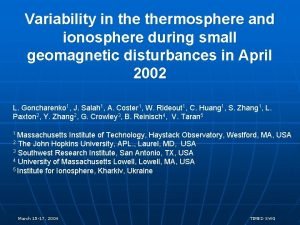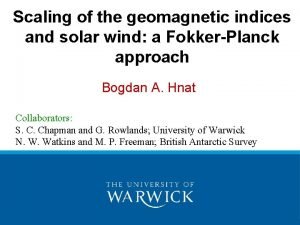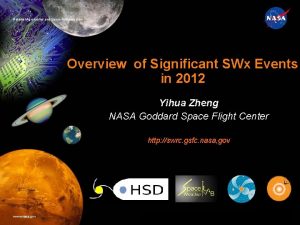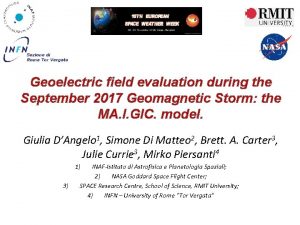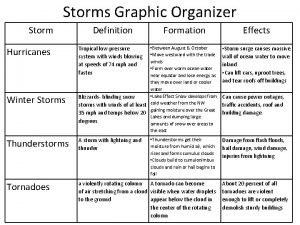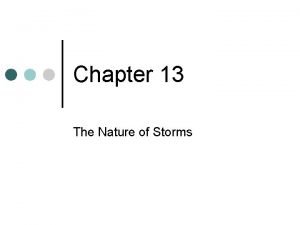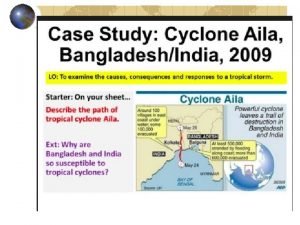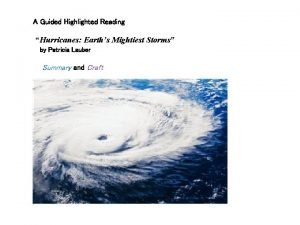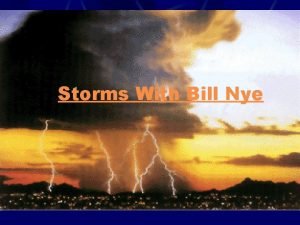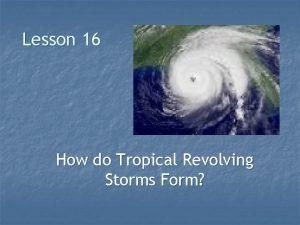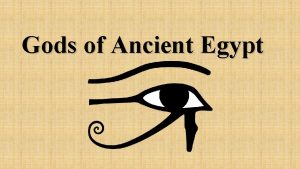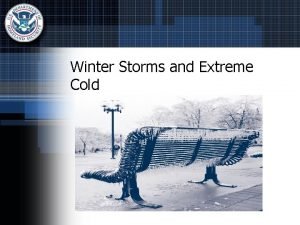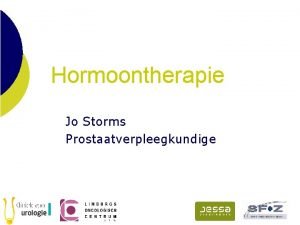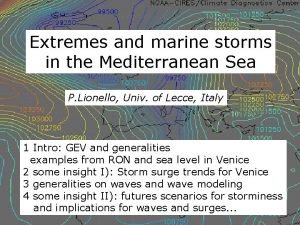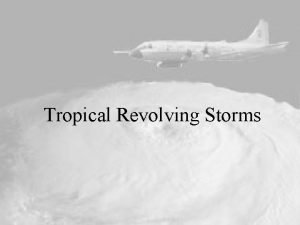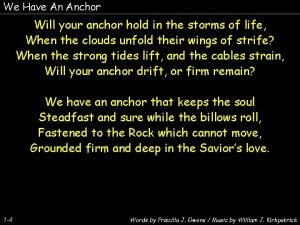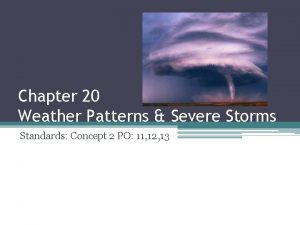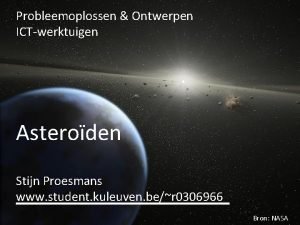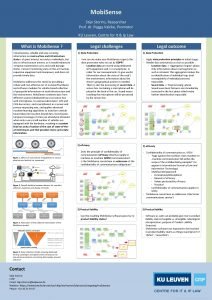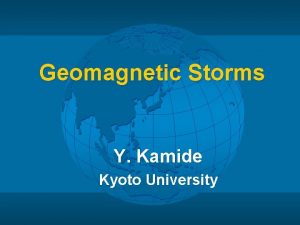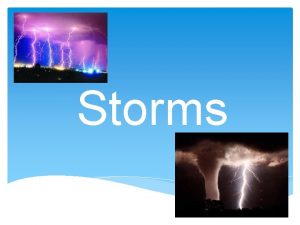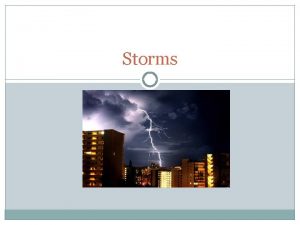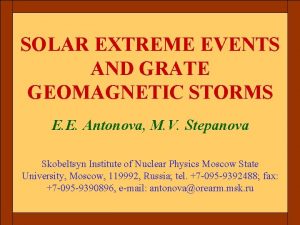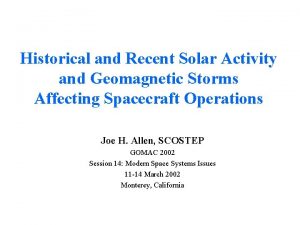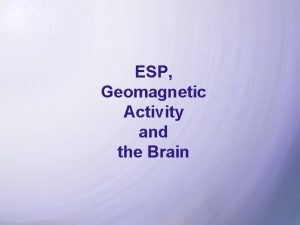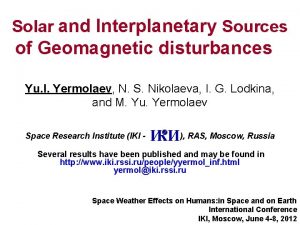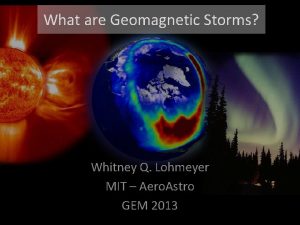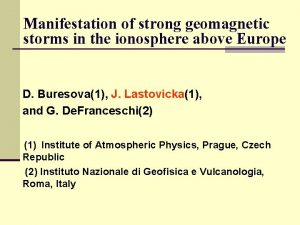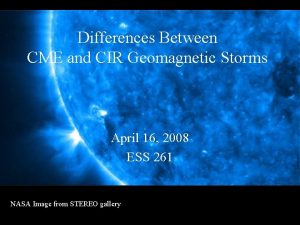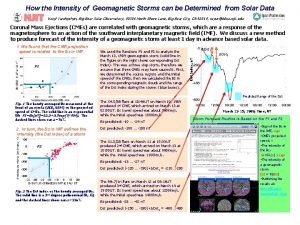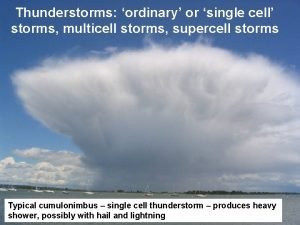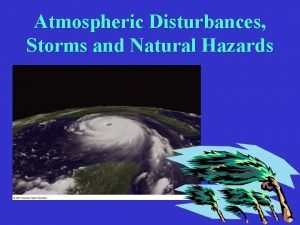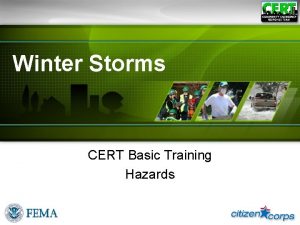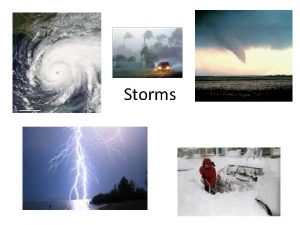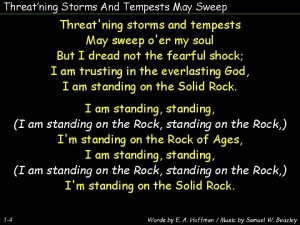Solar Sources of Large Geomagnetic Storms During Solar



























- Slides: 27

Solar Sources of Large Geomagnetic Storms During Solar Cycle 23 N. Gopalswamy (NASA/GSFC) G. Michalek, H. Xie, S. Yashiro (CUA) H. R. A. Howard (NRL) LWS CDAW Storms GMU March 14 -16 2005

Objective • To identify the solar sources of large (Dst < -100 n. T) geomagnetic storms of solar cycle 23, as reported by WDC (http: //swdcwww. kugi. kyotou. ac. jp/dstdir/index. htm), and document their properties. • To identify CMEs corresponding to the magnetic clouds reported during solar cycle 23 and study the strength of the geomagnetic storms associated with them. • Solar sources examined: - Solar front-side coronal mass ejections (CMEs) from SOHO/LASCO - Low-latitude coronal holes from Yohkoh/SXT; KPNO/He 10830; SOHO/EIT CDAW WG 1 -WG 4 Topic 2: What are the properties of the solar events that give rise t Geomagnetic storms? LWS CDAW Storms GMU March 14 -16 2005

Method • Examine all the CMEs that occurred 1 -5 days before the time of the storm. • Identify the front-side CMEs. If more than one, pick the fastest and widest (such CMEs are likely to travel large distances from the Sun). Compile CME properties. • For those storms without acceptable CMEs, examine low-latitude coronal holes When CMEs are isolated, it is easy to associate a storm with its CME As in the 2003 11 21 storm LWS CDAW Storms GMU March 14 -16 2005 Dst CMEs (height-time) Flares

A CME-related Storm Largest storm of cycle 23; Dst = -472 n. T Gopalswamy et al. 2005 GRL LWS CDAW Storms GMU March 14 -16 2005

Sometimes it is very difficult! Dst CME height-time Flares The extended main phase of the storm is probably due to many successive CMEs LWS CDAW Storms GMU March 14 -16 2005

Overview • • • 80 intervals were identified from Jan 1996 to December 2003. 12 intervals had possible fluctuation within the same storm (or extended storms due to multiple CMEs) 9 storms occurred during SOHO data gap Remaining 64 storms analyzed were analyzed 55 were CME-associated 3 were probably CIR-related 1 is being investigated for source CIR –associated storms: Dst=105, -128, -117 n. T CME-related storms: Dst = -100 to -472 n. T LWS CDAW Storms Fig. 1 Distribution of storm strengths. The dates of top 5 storms are marked GMU March 14 -16 2005

Longitudes of Storm-related CMEs N 18/55 = 33% 37/55 = 67% 15 W 20001029 2003/6/18 2000/4/7 W E 2003/11/20 East-West Asymmetry of solar sources is confirmed (Wang et al. 2002; Zhang et al. 2003) Larger storms (Dst < -200 n. T) seem to occur Close to the disk center (± 15 deg) LWS CDAW Storms GMU March 14 -16 2005 S O Dst < - 200 n. T O - 300 n. T < Dst < - 200 n. T O Dst < - 300 n. T

East limb Event -145 n. T Only east limb event; small storm; shock running into preceding CME LWS CDAW Storms GMU March 14 -16 2005

West limb Event - 288 n. T CME from W 66; sheath related storm LWS CDAW Storms GMU March 14 -16 2005

Solar-cycle Variation of Storms & CMEs The annual number of geomagnetic storms roughly tracks the number of front-side halo CMEs. However, there are more Halo CMEs than the storms. When weaker storms are included, the numbers become closer (Michalek et al. 2004). Also, for some asymmetric halos only the shock arrives at Earth because the CMEs are heading almost orthogonal to the Sun-Earth line. Year 1999 is unusual in that there were very few intense storms even though there were many Front-side Halo CMEs. LWS CDAW Storms GMU March 14 -16 2005

Properties of Storm–related CMEs Gopalswamy, 2004 Storm 001025 Storm 000404 030618 The speed distribution of storm-producing CMEs is similar to that of halo CMEs. The three near-limb CMEs appear as halos because of the disturbance above the opposite limb. At earth, the shock and sheath of these asymmetric halos are observed. The sheath contains southward B component causing the storms. The CMEs were full halos (69%) and partial halos (31%). LWS CDAW Storms GMU March 14 -16 2005

Dst-CME Speed Relationship There is a reasonable correlation between CME speed and the strength of the Dst Index (correlation coefficient = -0. 51). The scatter is very large. The single outlier with Dst ~ -100 n. T is due to a limb event. The earthward speed is likely to be much smaller Srivastava and Venkatakrishnan (2002) obtained the red line using 5 events, which does not seem to hold for the larger sample Blue line is obtained when storms associated with magnetic clouds are considered (r=-0. 55) LWS CDAW Storms GMU March 14 -16 2005

LWS/CDAW on Geomagnetic Storms http: //cdaw. gsfc. nasa. gov/ Three Geomagnetic Storms associated with Coronal holes Date of peak Dst 1996/10/23 - 105 n. T 2002/11/21 - 128 n. T 2003/07/16 - 117 n. T LWS CDAW Storms GMU March 14 -16 2005

CHs Associated with Large (Dst < -100 n. T) Geomagnetic Storms LWS CDAW Storms GMU March 14 -16 2005

Microwave Enhancement 104 K disk AR Filament LWS CDAW Storms GMU March 14 -16 2005

2003/07/15 19: 06 LWS CDAW Storms GMU March 14 -16 2005

1996/10/20 LWS CDAW Storms GMU March 14 -16 2005

2002/11/20 LWS CDAW Storms GMU March 14 -16 2005

Storms Associated with Magnetic Clouds • • Relaxing the Dst < -100 n. T criterion we considered magnetic cloud events alone and identified the associated front-side CMEs. There were 85 MCs observed by Wind. Only 66 had overlap with SOHO data The Dst – Vcme correlation similar. In addition to CME speed, the magnetic field and its orientation are also important. For example, the Dst-VB correlation (r=0. 81) is much better than the Dst-V correlation (r = 0. 55) Bz and total B have similar correlation with Dst LWS CDAW Storms GMU March 14 -16 2005

Storms Associated with Magnetic Clouds • Since CMEs are the near. Sun manifestations of magnetic clouds, the Dst – Vcme relationship should mimic the Dst-Vmc relationship. • The Dst-Vmc correlation cofficient(0. 74) is much larger than that for Dst. Vcme (0. 55) • However, the Dst-Vmc. B correlation (r=0. 79) is very similar to the Dst-Vcme. B correlation (r = 0. 81) LWS CDAW Storms GMU March 14 -16 2005

Summary • • • Most (95%) of the intense (Dst < -100 n. T) geomagnetic storms are associated with front-side fast and wide CMEs; the remaining (5%) are associated with corotating interaction regions. This confirms previous studies (e. g. Gosling, 1993) The properties of Storm-related CMEs are similar to those of halo CMEs. Most of the severe storms (Dst < -300 n. T) were associated with CMEs originating from close to the disk center (± 20 deg). There are generally more geoeffective CMEs originating from the western hemisphere of the Sun. However, the largest storm of cycle 23 originated from E 18 (2003 11 21 storm due to the 2003 11 18 CME). Asymmetric halos are not very geoeffective because only the shock flanks and/or shock sheaths arrive at Earth. In addition to the kinematic properties of CMEs, we must consider magnetic properties for a better understanding of their geoeffectiveness. This involves devising ways of estimating B when the CMEs are still near the sun. LWS CDAW Storms GMU March 14 -16 2005

Topic 2: Answers • • Location on the Sun: Center-West Flares: Bigger on the average CME properties: Faster & Wider on the average SEP events: Overlap in longitude; Avg SEPevent longitude more western • Dst-Vcme correlation: 0. 55, similar to Vicme-Dst • Dst – Vcme. B highest correlation 0. 81 • CIR storms: 3/76 ~ 4% LWS CDAW Storms GMU March 14 -16 2005

References • Gopalswamy, 2004, in ASSL series, ed. G. Poletto & S. Suess, chapter 8, in press. • Gosling, J. T. , 1993, JGR, 98, 18937 • Michalek, G. et al. 2004, under preparation • Srivastava, N. & Venkatakrishnan, P. V. , 2002, GRL 29, 1287 • Wang, Y. -M. et al. , 2002, JGR, 107, 1340 • Zhang, J. et al. , 2003, Ap. J, 582, 520 LWS CDAW Storms GMU March 14 -16 2005

Longitudes of Storm-related CMEs N 18/55 = 33% SEP 37/55 = 67% 15 W E East-West Asymmetry of solar sources is confirmed (Wang et al. 2002; Zhang et al. 2003) Larger storms (Dst < -200 n. T) seem to occur Close to the disk center (± 15 deg) LWS CDAW Storms GMU March 14 -16 2005 W S O Dst < - 200 n. T O - 300 n. T < Dst < - 200 n. T O Dst < - 300 n. T

Newton 1943 LWS CDAW Storms GMU March 14 -16 2005

B and Bz have similar correlation with Dst r = 0. 74 for |Bz| LWS CDAW Storms GMU March 14 -16 2005

Worst-Case Scenario • There were only 25 of the 8000 CMEs had speed > 2000 km/s; only 4 with speed > 2500 km/s • Inferred speeds of historical events is < 2800 km/s • CMEs probably have a speed limit of ~ 3000 km/s • This limit arises from the maximum energy extractable from an active region (<1034 erg) • The Sun-Earth Travel time of shocks has a limit of ~ half a day LWS CDAW Storms t = a. bv + c a= 151. 002, b=0. 998625, and c=11. 5981 GMU March 14 -16 2005
 Geomagnetic
Geomagnetic Geomagnetic
Geomagnetic Geomagnetic
Geomagnetic Geomagnetic
Geomagnetic Print sources and web sources
Print sources and web sources Water resource
Water resource Winter storms definition
Winter storms definition Chapter 13 the nature of storms
Chapter 13 the nature of storms Distribution of tropical storms
Distribution of tropical storms Hurricanes earth's mightiest storms
Hurricanes earth's mightiest storms Bill nye storms
Bill nye storms Tropical revolving storm
Tropical revolving storm Storms wijn
Storms wijn Taurus egyptian god
Taurus egyptian god Winter storms facts
Winter storms facts Jo storms
Jo storms Mark storms
Mark storms Hurricanes tropical storms
Hurricanes tropical storms Storms in the mediterranean sea
Storms in the mediterranean sea Tropical revolving storms
Tropical revolving storms We have an anchor
We have an anchor Chapter 20 weather patterns and severe storms
Chapter 20 weather patterns and severe storms Chapter 20 weather patterns and severe storms
Chapter 20 weather patterns and severe storms Hyetograph example
Hyetograph example Egyptian god of storms
Egyptian god of storms Stijn storms
Stijn storms Stijn storms
Stijn storms Buy solar panels wholesale
Buy solar panels wholesale
